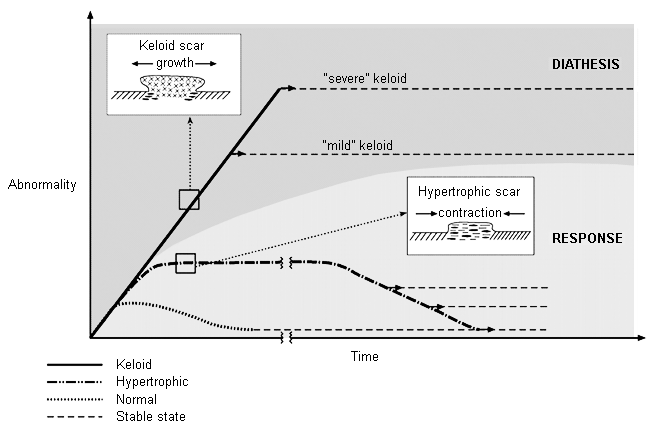Aetiology
Keloid scarring usually develops in response to inciting inflammation or trauma to the dermis. Common inciting events include:[7][8]
Acne
Body piercing
Tattoos
Insect bites
Vaccinations (e.g., BCG)
Surgery
Follicular inflammation
Keloids typically occur in patients with darker skin types, suggesting a potential role of melanin and/or melanocytes in scarring. However, one survey in Kenya and Tanzania reported a similar prevalence of keloids in people with albinism.[9]
Numerous patients with keloid scars report a positive family history of pathological scarring, which may suggest that there are genetic factors implicated in the pathophysiology. Studies of familial keloid cases have identified associated single nucleotide polymorphisms and susceptibility loci on chromosomes 1q41, 2q23, 7p11, and 10q23.31 in Japanese, African-American, and Han Chinese families.[10][11][12] Responsible genes have not yet been identified.
Growth factors are also thought to have a role. There is an observed resistance to apoptosis in keloid fibroblasts, which may contribute to the slowly progressive and long-lasting nature of the lesions.[13] Growth factors associated with the pathogenesis of keloid scarring include connective tissue growth factor (CTGF) and platelet-derived growth factor (PDGF). A number of other growth factors are under investigation.[14][15]
Hormones may also play a part, given the observation that keloid scars often develop or worsen at puberty and during pregnancy, and that there is often an improvement after the menopause.[16] Oestrogen has vasodilatory action, and hence may enhance levels of inflammation.[17]
Pathophysiology
The exact pathophysiology of keloids remains unclear. In part, this is due to the heterogeneous nature of the scar and the multifactorial nature of the possible aetiological associations.[18]
The scar arises from excessive dermal collagen deposition, with more cellular activity at the periphery than in the centre; central cells demonstrate a decreased tendency to undergo apoptosis. The extracellular matrix and vascular architecture of keloid scars varies within each scar and between scars, and is distinctly different in the spectrum of heterogeneity from that of hypertrophic scarring.
Keloid is a unique form of scarring because it does not pass through a cycle of proliferation, stabilisation, and involution. Rather, it proliferates and then stabilises. However, the point of stabilisation and consequent size varies considerably, both between and within patients. Unlike hypertrophic scarring, keloids are not typically associated with contractures. [Figure caption and citation for the preceding image starts]: The timelines for normal, hypertrophic, and keloid scar formation. Keloid scarring is different in that it does not mature (involute); expansion may occur but, in contrast to hypertrophic scarring, contraction does not occur either in the scar or in the surrounding tissueFrom the collection of Professor Andrew Burd, used with permission [Citation ends].
Use of this content is subject to our disclaimer